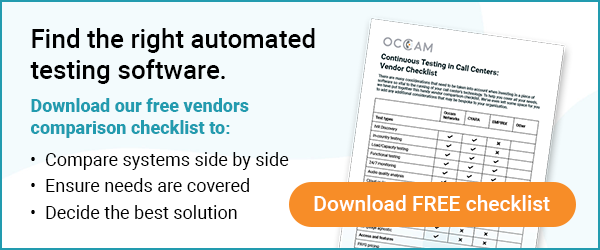Thanks to the internet, social media, and the rapid pace of innovation, customer expectations are changing faster than some companies can keep up with.
In a competitive market where customer service delivery significantly affects how brands are perceived, organizations need a new and proactive approach to responding to changes and providing value to the customer.
Implementing DevOps for faster delivery
Aligning the efforts of your development and operations teams is the first step to making a shift in your approach to continuous improvement. DevOps utilizes automated testing to quickly detect bugs, provide enhancement opportunities and facilitate innovation in the delivery of your customer experience (CX).
What does DevOps look like in practice?
- Your company is dedicated to testing and upgrading testing skills.
- Changes to the environment are supported through continuous testing.
- Operations and development teams are incorporated with testers.
- Testing from the carrier through to the agent is fully automated.
- Shift left for faster continuous testing throughout the development lifecycle.
Continuous testing
The benefit of continuous testing is the reassurance that changes are being delivered to the production environment effectively. At the same time, DevOps teams have up to date insight into how these changes are performing.
This speeds up responsiveness and improves the DevOps lifecycle significantly. Errors and bugs are located quickly, and the company does not incur costly downtime or delay to delivery timescales.
The 5 things to consider for your successful continuous testing implementation
Due to the various bottlenecks and approval ranks that traditional automating testing tools are subject to, optimization can be a slow and staggered process.
When looking into a testing platform, organizations should evaluate the tools based on the following criteria:
1. Accessibility
Most automated service delivery systems now operate around the clock. To meet your organization's needs, your team needs 24/7 access to the tools.
Furthermore, the license should allow you to scale and add users without incurring extra costs.
2. Usability
Try before you buy. Not every dashboard or tool is going to entice user onboarding. To meet your DevOps transition objectives, your new testing tool must be intuitive and provide unrestricted access in order to promote early adoption and confidence in the methodology being applied.
3. Features
Your organization's needs and testing requirements will continuously be evolving as you look to scale or bring new features into your contact center’s infrastructure. Look for an automated testing tool that offers access to all features within a single license to ensure it can grow with your business to provide continuity in use and adoption, without any additional licensing costs further down the line.
4. Pricing
There are three crucial things you require from your automated testing tool: immediate value for money, low to zero setup costs, the flexibility to meet your growing demands.
It's crucial to assess the transparency of the pricing model you are being sold and to ensure that it supports your DevOps Initiatives.
5. Integrations
From an infrastructural point of view, you want to ensure that your new automated testing platform configures with your existing hardware and software. This consideration makes adoption and implementation faster, more cost-effective, and easier for your entire team.
Choosing continual testing software for your contact center
As you explore the market for the best suitable platform for your needs, why not take a look at our free Vendor Comparison Checklist. We cover all the key points you need to tick off to ensure that your investment aligns with your company's goals and offers genuine potential for a DevOps methodology to flourish.




